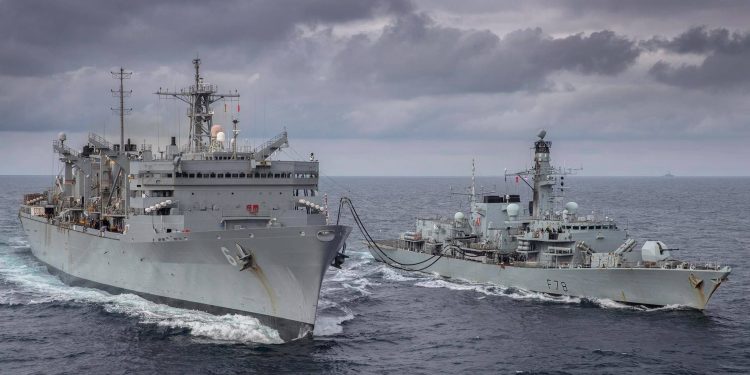NORWEGIAN SEA: U.S. 6th Fleet (C6F) conducted a bilateral naval anti-submarine warfare (ASW) exercise with the U.K., above the Arctic Circle, May 1, 2020.
Four ships from two nations, a U.S. submarine, and a U.S. P8-A worked together, in the Norwegian Sea, to conduct training in the challenging conditions in the Arctic.
For the exercise, Arleigh Burke-class Aegis destroyers USS Donald Cook (DDG 75) and USS Porter (DDG 78), and fast combat support ship USNS Supply (T-AOE 6), were joined by the Royal Navy’s HMS Kent (F 78). Additionally, a U.S. submarine, as well as a P8-A Poseidon multi-mission maritime patrol and reconnaissance aircraft from Patrol Squadron (VP) 4 supported the training. This exercise reinforces the combined training that the nations received last month while participating in the U.K’s Submarine Command Course (SMCC).
“For more than 70 years, 6th Fleet has operated forces across the region in support of maritime security and stability. Our regional alliances remain strong because of our regular operations and exercises with partner navies, and we welcome this opportunity to work collaboratively at sea, while enhancing our understanding of Arctic operations,” said Vice Adm. Lisa Franchetti, commander, U.S. 6th Fleet.
The multinational antisubmarine exercise in the High North, made up of approximately 1,200 Sailors from the U.S. Navy and Royal Navy, is the latest in a series of U.S. ships operating above the Arctic Circle. In 2018, elements of the USS Harry S. Truman Carrier Strike Group and the USS Iwo Jima Expeditionary Strike Group operated above the Arctic Circle in support of NATO exercise Trident Juncture. In 2019, the forward deployed destroyer USS Donald Cook and a SAG from U.S 2nd Fleet led by USS Normandy (CG 60) and USS Farragut (DDG 99) also operated separately above the Arctic Circle.
“We are working with our partners to enhance our combined capabilities as we conduct maritime security operations and training in the Arctic region,” said Franchetti. “Our ships must be prepared to operate across all mission sets, even in the most unforgiving environments. This is especially critical in the Arctic, where the austere weather environment demands constant vigilance and practice.”
The United States is an Arctic nation and has enduring security interests in the Arctic Region. We work with our Arctic and European partners to ensure an open Arctic by continuing freedom of navigation and overflight through the region, as well conducting land, air, and sea operations required for deterrence, presence, and Arctic security.
C6F forces deploy throughout the European and African theater and continue to operate above the Arctic Circle to support a secure and stable region, working cooperatively with other nations to address shared challenges. The two U.S. destroyers, based in Rota, Spain, support NATO’s integrated air missile defense architecture. These forward deployed naval forces-Europe ships have the flexibility to operate throughout the waters of Europe and Africa, from the Cape of Good Hope to the Arctic Circle demonstrating their mastery of the maritime domain.
“One of the best attributes of our surface force is that we can aggregate at will, transitioning seamlessly from independent ships to coordinated operations,” said Capt. Joseph A. Gagliano, Commander, Task Force 65, commander, Destroyer Squadron 60. “Our interoperability with our allies is so good that we can deploy multinational naval forces with minimal notice. That’s the real power of NATO.”
U.S. 6th Fleet, headquartered in Naples, Italy, conducts the full spectrum of joint and naval operations, often in concert with allied and interagency partners, in order to advance U.S. national interests and security and stability in Europe and Africa.











